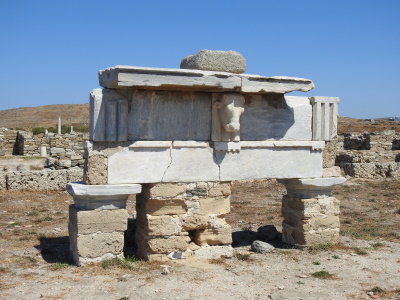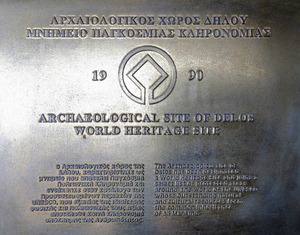Delos

Delos is a small island that holds the archaeological site of one of the greatest Hellenistic sanctuaries.
The island was considered sacred in ancient Greek culture as it was the mythological birthplace of Apollo and Artemis. The feast of the Delians, which was celebrated every four years, was one of the major events in the Greek world. Later Delos began to prosper as a cosmopolitan Mediterranean port, which can be seen in the rich public and residential buildings at the site.
Community Perspective: Delos can easily be reached by one of the daily ferries from Mykonos. It’s a vast and unshaded site. The green walking trail (to the upper area with the foreign-influenced buildings) and the museum are recommended.

Map of Delos
Community Reviews
Els Slots

I visited Delos right from the overnight ferry between Samos and Mykonos. The ferry was supposed to arrive at 7.35, got an hour’s delay, and with the necessary hop on the SeaBus from Mykonos cruise/ferry port to the Old Port I arrived just in time to pick up my pre-booked tickets for the 10 a.m. departure. The Delos Tours boat was fully packed, I think there were at least 200 people on board for the half-hour crossing to the island of Delos. Once at Delos, you still have to buy an 8 EUR entrance ticket at the ticket office (which also holds the UNESCO plaque). I knew this was coming, so made sure I was one of the first off the boat.
There’s some restoration going on at the moment at Delos: the on-site museum is closed and the South Stoa is covered by a huge iron construction. There is still more than enough to see though: I spent 2.5 hours there, combining the blue and green itineraries that are scarcely signposted at the site itself and much easier followed from the useful map they give you at the entrance. I started from the end, as to further avoid the crowds. To give an idea of how large the site is: the map has 100 numbered entries!
From the north of the settlement (with the famous Lions Terrace) I walked 'upwards' towards the eastern part. I found that area, covered by the green route, the most interesting. As it is located on a hill, you have beautiful views over the entire site and you can see how densely built up it was.
In this area, you’ll also notice the ‘foreign’ influences that Delos is known for. The temple for the Egyptian goddess Isis is the best one still standing. The Phoenician owner of the House of the Dolphins had a Tanit mosaic placed in his vestibule.
There is also a large theater with seating for 6,500 spectators, of which the 'normal' seats have now almost completely disappeared. Only the seats of honor – with backrests – in the front row are still there. Next door is an impressive reservoir to store rainwater and feed it to the theater. Cisterns and large pitchers are common elements on this dry island anyway.
Near the theater, the most beautiful houses were located. Their walls are usually still standing. Many have a large mosaic in their courtyard. At the rest of the site many of the mosaics are covered with pebbles or plastic, but luckily they can still be seen here in their full glory. There is, among others, the House of the Masks (with images of masks used in the theater), the House of Dionysus (with a courtyard surrounded by columns), and the House of the Trident (with a picture of a dolphin with an anchor).
The strength of the site, and it is really above average, also lies in its numerous statues and sculptures. Most (or all?) are replicas now, but I enjoyed the depictions of bulls and lions. There even is a grand display of Erotic Art along one of the main roads, showing two huge phalluses.
Read more from Els Slots here.
Klaus Freisinger

Delos is famous for both mythological and actual historic reasons. It was supposedly the birthplace of Apollo and his sister Artemis, and was thus revered as a sacred site from earliest times. The mighty statue of Apollo was considered to be the most sacred site in Greece (only the base survives today). The island was thus a destination for countless pilgrims, and not only hosted a famous oracle and the Delian Festival, but also the main slave market of the Mediterranean world. During the time of the Delian league and the Athenian hegemony on the seas, it was the location of the league's huge treasury. The island also flourished during the early Roman era, when it was a multinational trading port with about 30,000 inhabitants, while today it is uninhabited except for wardens and archaeologists. Today it is the largest archaeological site in Greece and makes a great excursion from Mykonos, only a 30-minute boat ride away. There are several crossings from the Old Port in Mykonos every day. Don't miss the museum - it's included in the ticket price and holds the original lion statues and the original tiger mosaic. I bought my boat ticket a few hours before at the ticket booth, but it was mid-September, and maybe not that crowded anymore. In summer, advance booking may be a good idea. Be aware, though, that there is no shade on the island (except in the museum), and going for the midday tour is probably not a good idea. Adding a guide to your booking is also recommended, otherwise it would be hard to make sense of all the archaeological remains.
Ilya Burlak

Delos archaeological site is vast and is among the most impressive of its kind. Ancient ruins everywhere require a non-trivial application of imagination to see beyond the piles of stones and the occasional surviving pillar, but Delos offers more than a few structures and artifacts that help visualize a bustling settlement from two and half thousand of years ago. The island was a major cult center for most of the first millennium BC, as well as an important trading post in the later centuries of that period. It was largely abandoned and uninhabited for the following two millennia, which contributed to the exceptional richness of its archaeological remains.
I visited Delos in the summer of 2018.
The aforementioned piles of stones and occasional surviving columns prevail at this site as in many others, but walking through the site, you come across occasional buildings that more or less retain their entire structures, or at least retain key features, such as doors or windows. In a few houses, despite exposure to the elements, rich details such as mosaic floors survived in a fairly good shape. The amphitheater at Delos, conversely, is among the least preserved areas of the site – its aerial photos found on the web look more impressive than the ground-level perspective.
Among the most amazing surviving artifacts are the Naxian marble Lions, dedicated to Apollo around 600 BC. In addition to them, a fair-sized collection of various items can be seen in the onsite museum.
Over a hundred points through the site are marked as individual buildings or places of importance, many accompanied by descriptive stands with information in 3 languages (Greek, French, English).
We had three hours for exploring the Delos archaeological site as part of a day-cruise itinerary. That is sufficient time for any layman visitor to discover all of the major points of interest and peruse the museum. A true enthusiast may not be satisfied even with a full day here. Naxos, Paros, and Mykonos all offer daily options to visit Delos in the summer season.
Read more from Ilya Burlak here.
John booth

Delos Island is accessible by daily ferries from Mykonos. The WHS takes up half of the area of the island, so to see it all means a lot of walking. In the middle of the island is a museum containing statues and artifacts found on the island, one of the bvest in Greece.
In antiquity Delos was a consular city, where governments around the Mediterranean, and as far away as Syria, sent representatives to resolve disputes, arrange trade etc.
The residents obviously enjoyed a high degree of comfort, judging from the size of their houses, the amenities and entertainment available.
Community Rating
- : Thijs van den Berg Farinelli Frediehung Van Hung Marty Priyaranjan Mohapatra Mihai Dascalu Lisu Marian
- : MaxHeAnouBen Simonh Jasonfd247 MC Jeanne OGrady
- : Paczeterson Reisedachs Klaus Freisinger AT8 Nicole Lampos WILLIAM RICH Kayakka Hadrianus MichaelH Ilya Burlak
- : Zoë Sheng Solivagant Els Slots Alexander Lehmann Philipp Peterer Kjsisney Kasileigh Argo Martina Rúčková Alex
- : Szucs Tamas Shandos Cleaver Gordon Mitchell Joyce van Soest Lucio Gorla Philipp Leu Dorejd Juha Sjoeblom Yevhen Ivanovych Sbshipway
- : Harry Mitsidis Dimitrios Polychronopoulos Hammeel
- : Ivan Rucek George Gdanski Alexander Parsons CugelVance
Site Info
- Full Name
- Delos
- Unesco ID
- 530
- Country
- Greece
- Inscribed
- 1990
- Type
- Cultural
- Criteria
-
2 3 4 6
- Categories
- Archaeological site - Ancient Greece
- Link
- By ID
Site History
1990 Inscribed
Site Links
Unesco Website
Official Website
Related
In the News
Connections
The site has 34 connections
Art and Architecture
Constructions
Geography
History
Human Activity
Religion and Belief
Science and Technology
Timeline
Trivia
Visiting conditions
WHS Names
WHS on Other Lists
World Heritage Process
Visitors
151 Community Members have visited.
The Plaque
 (photo by Solivagant)
(photo by Solivagant)